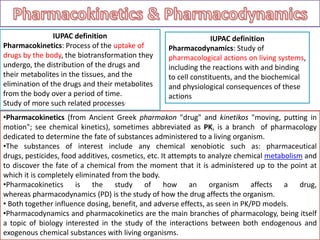
Pharmacokinetics Drug Fate Study
- 1. •Pharmacokinetics (from Ancient Greek pharmakon "drug" and kinetikos "moving, putting in motion"; see chemical kinetics), sometimes abbreviated as PK, is a branch of pharmacology dedicated to determine the fate of substances administered to a living organism. •The substances of interest include any chemical xenobiotic such as: pharmaceutical drugs, pesticides, food additives, cosmetics, etc. It attempts to analyze chemical metabolism and to discover the fate of a chemical from the moment that it is administered up to the point at which it is completely eliminated from the body. •Pharmacokinetics is the study of how an organism affects a drug, whereas pharmacodynamics (PD) is the study of how the drug affects the organism. • Both together influence dosing, benefit, and adverse effects, as seen in PK/PD models. •Pharmacodynamics and pharmacokinetics are the main branches of pharmacology, being itself a topic of biology interested in the study of the interactions between both endogenous and exogenous chemical substances with living organisms. IUPAC definition Pharmacokinetics: Process of the uptake of drugs by the body, the biotransformation they undergo, the distribution of the drugs and their metabolites in the tissues, and the elimination of the drugs and their metabolites from the body over a period of time. Study of more such related processes. IUPAC definition Pharmacodynamics: Study of pharmacological actions on living systems, including the reactions with and binding to cell constituents, and the biochemical and physiological consequences of these actions
- 2. •Liberation – the process of release of a drug from the pharmaceutical formulation. •Absorption – the process of a substance entering the blood circulation. •Distribution – the dispersion or dissemination of substances throughout the fluids and tissues of the body. •Metabolism (or biotransformation, or inactivation) – the recognition by the organism that a foreign substance is present and the irreversible transformation of parent compounds into daughter metabolites. •Excretion – the removal of the substances from the body. In rare cases, some drugs irreversibly accumulate in body tissue.
- 3. Drug Delivery Systems A drug delivery system (DDS) is defined as a formulation or a device that enables a therapeutic substance to selectively reach its site of action without reaching the nontarget cells, organs, or tissues.
- 4. A liposome is a spherical-shaped vesicle that is composed of one or more phospholipid bilayers, which closely resembles the structure of cell membranes. The ability of liposomes to encapsulate hydrophilic or lipophilic drugs have allowed these vesicles to become useful drug delivery systems.
- 5. Indian Pharmacopeia oIndian Pharmacopoeia Commission (IPC) is an autonomous institution of the Ministry of Health and Family Welfare which sets standards for all drugs that are manufactured, sold and consumed in India. oThe set of standards are published under the title Indian Pharmacopoeia (IP) which has been modelled on and historically follows from the British Pharmacopoeia. The standards that are in effect since 1 December 2010,are the Indian Pharmacopoeia 2010 (IP 2010). o The Pharmacopoeia 2014 was released by Health Minister Ghulam Nabi Azad on 4 November 2013. oThe Pharmacopoeia 2018 was released by Secretary, Ministry of Health & Family Welfare, Government of India. oThe IPC was formed according to the Indian Drugs and Cosmetics Act of 1940 and established by executive orders of the Government of India in 1956 oThe actual process of publishing the first Pharmacopoeia started in the year 1944 under the chairmanship of Col. R. N. Chopra. The I. P. list was first published in the year 1946 and was put forth for approval. The titles are suffixed with the respective years of publication, e.g. IP 1996. The following table describes the publication history of the Indian Pharmacopoeia.
- 6. The United States Pharmacopeia (USP) is a pharmacopeia (compendium of drug information) for the United States published annually by the United States Pharmacopeial Convention (usually also called the USP), a nonprofit organization that owns the trademark and also owns the copyright on the pharmacopeia itself. The USP is published in a combined volume with the National Formulary (a formulary) as the USP-NF If a drug ingredient or drug product has an applicable USP quality standard (in the form of a USP- NF monograph), it must conform in order to use the designation "USP" or "NF". Drugs subject to USP standards include both human drugs (prescription, over-the-counter, or otherwise) and animal drugs. USP-NF standards also have a role in US federal law; a drug or drug ingredient with a name recognized in USP- NF is considered adulterated if it does not satisfy compendial standards for strength, quality or purity. USP also sets standards for dietary supplements and food ingredients (as part of the Food Chemicals Codex). USP has no role in enforcing its standards; enforcement is the responsibility of the U.S. Food and Drug Administration (FDA) and other government authorities in the United States
- 7. Cheminformatics (also known as chemoinformatics) refers to use of physical chemistry theory with computer and information science techniques—so called "in silico" techniques—in application to a range of descriptive and prescriptive problems in the field of chemistry, including in its applications to biology and related molecular fields. •Such in silico techniques are used, for example, by pharmaceutical companies and in academic settings to aid and inform the process of drug discovery, for instance in the design of well- defined combinatorial libraries of synthetic compounds, or to assist in structure-based drug design. •The methods can also be used in chemical and allied industries, and such fields as environmental science and pharmacology, where chemical processes are involved or studied •Cheminformatics has been an active field in various guises since the 1970s and earlier, with activity in academic departments and commercial pharmaceutical research and development departments. •The term chemo informatics was defined in its application to drug discover, for instance, by F.K. Brown in 1998 •Application of Chemoinformatics 1)Digital libraries 2)Unstructured data 3)Structured data mining and mining of structured data 4) Database mining 5)Graph mining 6)Molecule mining 7) Sequence mining 8) Tree mining